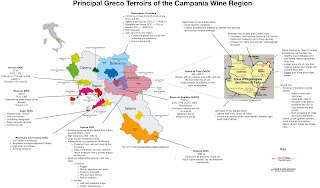Irpinia, the ancient name of Campania's Avellino Province, is home to three of the four regional DOCG production zones: Taurasi (red), Fiano di Avellino, and Greco di Tufo (the latter two both white wines). I treat the Greco variety, and its wines, in this post.
The Greco group of grapes, according to Ian D'Agata (Native Wine Grapes of Italy), "along with the Malvasias, may be the most confusing of all grapes." While the grapes, for the most part, are Greek imports, "many other grapes that never graced Greek soils were named 'greco' too because they were used to make wine in the 'Greek style' ... Rather than a family, the Grecos are a group of grapes sharing the same name and very little else."
"The most famous and best-known of all Italian Greco varieties is simply called Greco, and it is the one with which the world famous Greco di Tufo wine is made" (D'Agata). It is this variety that I will be focusing on in this post.
Greco is one of the oldest native white grape varieties in southern Italy, with roots dating back to the Greek colonization of the region. The main characteristics of the variety are detailed in the below chart.
While instances of the variety can be found in Calabria, Puglia, Lazio,, and Tuscany, it is most widely deployed in Campania. The Greco wines authorized in the region are shown in the chart below.
The chart shows, first of all, the versatility of the Greco grape in that it can be used for the production of sparkling (both Charmat and Metodo Classico), still, and dessert wines. Secondly the variety is used in blends in the coastal zones while it is mostly the dominant variety in the inland wines.
While the variety is grown across the region, it is in Tufo, and surrounding municipalities, that the variety expresses itself best. The combination of soils, cooler temperatures, persistent sunshine, and high diurnal temperature variation combine to produce wines of intense aromas and "particular mineral notes." The Campania Greco di Tufo terroirs are illustrated in the chart below.
Feudi di San Gregorio divides the Greco di Tufo zone into three broad regions with the most classic examples of the wine being produced in the central zone on the right bank of the Sabato River. Ian D'Agata focuses in even tighter, classing Tufo and Santa Paolina as Grand Cru growing zones and Montefusco as a Premier Cru, with mineral, refined wines from Tufo and bigger, more structured wines from the remaining two.
This post wraps up my coverage of the Campania DOCGs but no review of Campanian wines would be complete without a discussion of the Falanghina variety and its wines. I will undertake that task in my next post.


